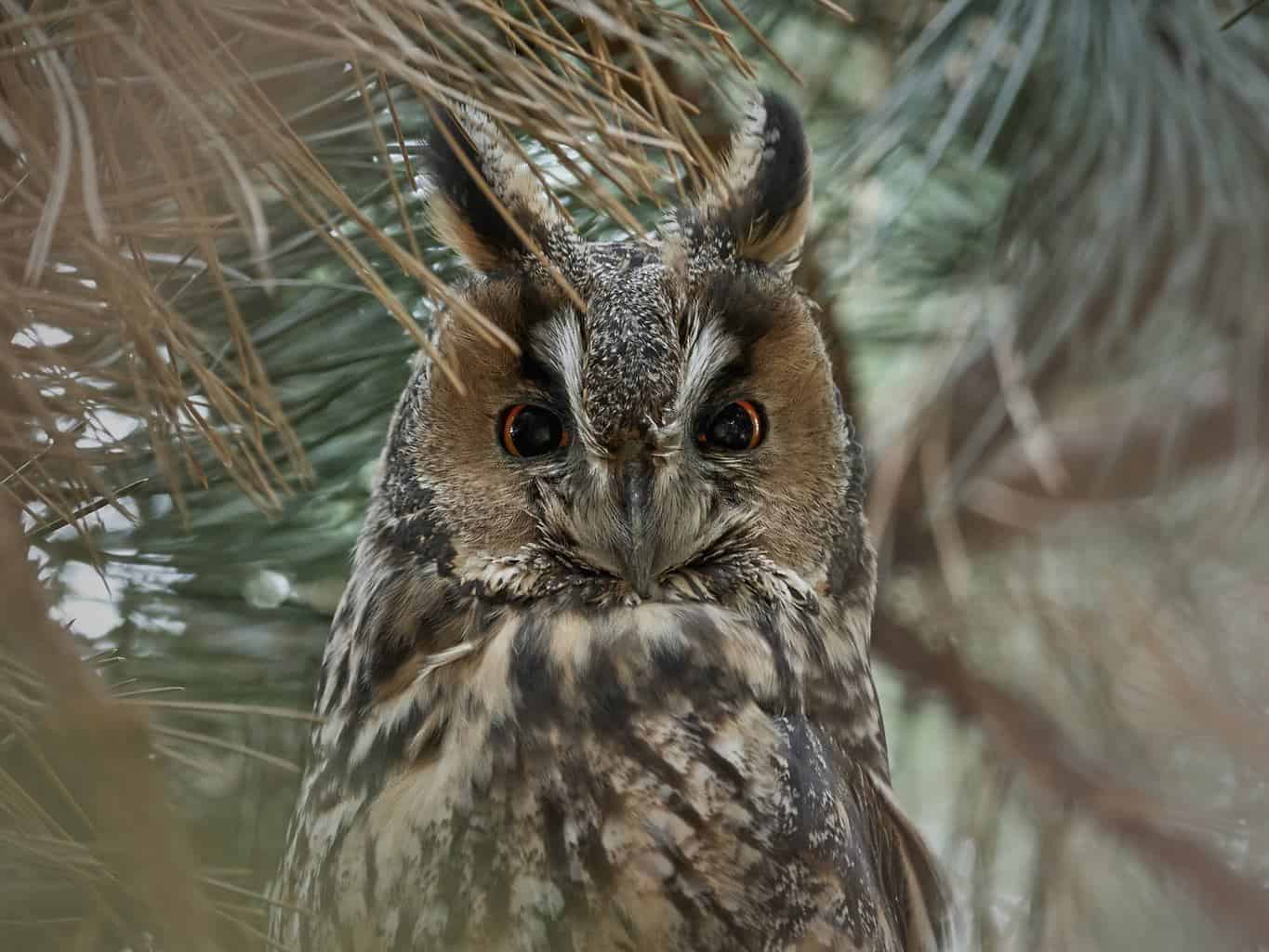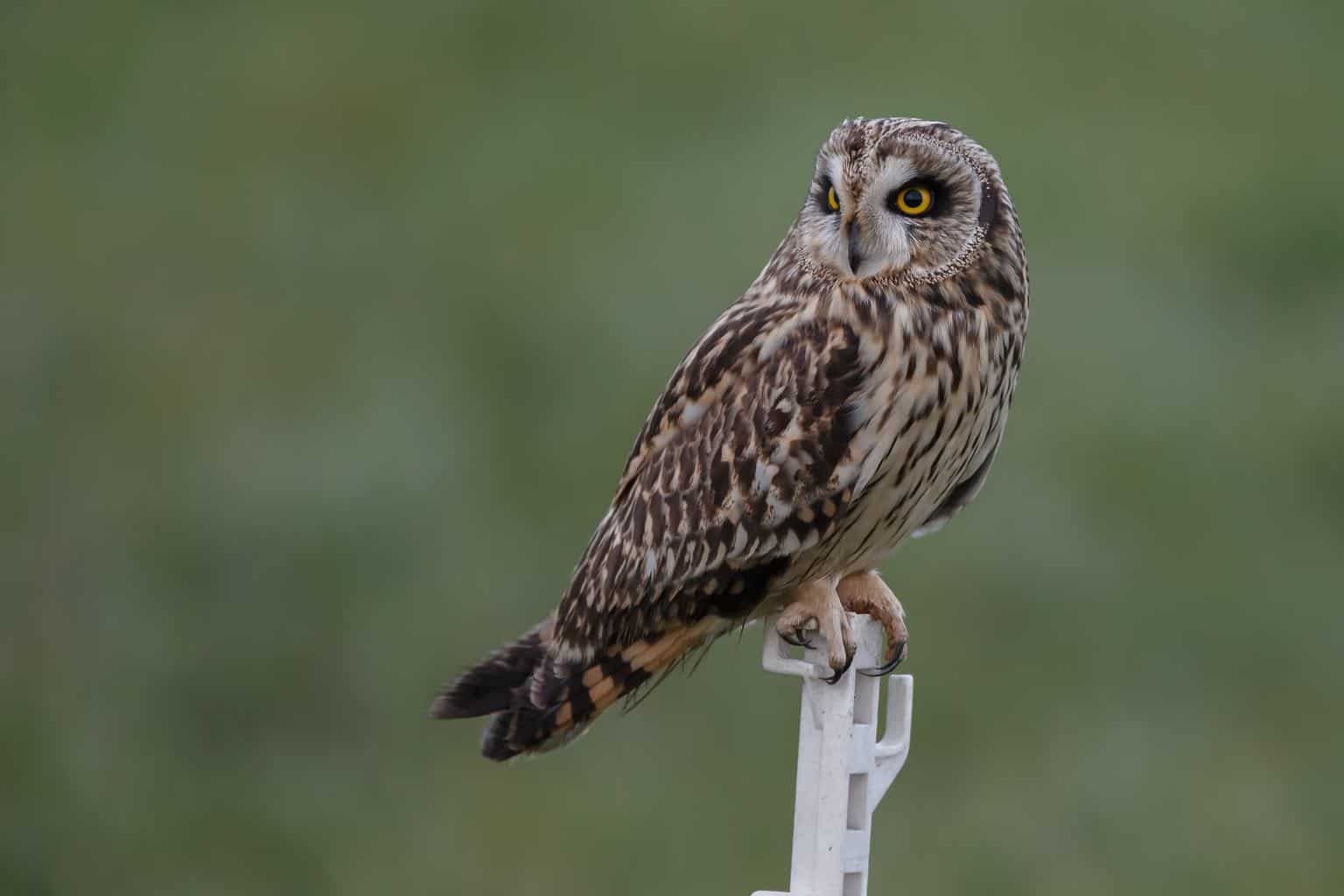There are over 400 bird species included in the official bird’s checklist of this state. Out of this diverse bunch, you can spot 12 species of owls in North Dakota, which we’ll be discussing below.
Barn Owl

- Scientific Name: Tyto alba
- Length: 12.6 to 15.8 inches (32 to 40 cm)
- Weight: 14.1 to 24.7 oz (400 to 700 g)
- Wingspan: 39.4 – 49.2 inches (100 to 125 cm)
Barn Owls are larger than Screech-Owls but smaller than Great Horned Owls. These medium-sized birds have long, rounded wings and short tails, and their heads are smoothly rounded without ear tufts.
Pale with dark eyes, the monkey-faced Barn Owls have bodies that are a mix of buff and gray, but their faces are distinctively white — impossible to confuse with any other owl species out there.
Although all owls are nocturnal birds, Barn Owls are one of the least often seen species by day. Their deeply nocturnal nature is what helps them escape detection.
Eastern Screech-Owl

- Scientific Name: Megascops asio
- Length: 6.3 to 9.8 inches (16 to 25 cm)
- Weight: 4.3 to 8.6 oz (121 to 244 g)
- Wingspan: 18.9 to 24.0 inches (48 to 61 cm)
Eastern Screech-Owls are short with stocky bodies, big heads, and virtually no neck. They’re either mostly reddish-brown (rufous) or mostly grey, with bands and spots to provide excellent camouflage against tree bark.
Their wings are rounded, their tails are squared, and their ear tufts are pointed and raised. This species has yellow eyes and it lives mainly in second-growth forests, particularly at lower elevations.
Most birdwatchers recognize Eastern Screech-Owls only from their sounds – including whinnies, trills, moans, rattles, and screeches. They avoid areas populated by larger owls, especially the Great Horned Owl.
Great Horned Owl

- Scientific Name: Bubo virginianus
- Length: 18.1 to 24.8 inches (46 to 63 cm)
- Weight: 32.1 to 88.2 oz (910 to 2500 g)
- Wingspan: 39.8 to 57.1 inches (101 to 145 cm)
Also known as Cat Owls or Hoot Owls, Great Horned Owls are mottled gray-brown with reddish-brown faces and a clear white patch on their throats. Their bodies are large and thick, sporting two raised tufts on the head along with wide, rounded wings.
In general, Great Horned Owls are the nocturnal counterparts of the Red-tailed Hawk as they hunt through the night for small mammals and birds.
These predators inhabit all types of forests and occasionally feed on skunks and raccoons. They’re well-adapted to life alongside humans, preying on the squirrels and rats that people attract.
Snowy Owl

- Scientific Name: Bubo scandiacus
- Length: 20.5 to 27.9 inches (52 to 71 cm)
- Weight: 56.4 to 104.1 oz (1600 to 2950 g)
- Wingspan: 49.6 to 57.1 inches (126 to 145 cm)
Snowy Owls are one of the most beautiful species on today’s list. They’re quite large birds with smoothly rounded heads and no ear tufts. Their bodies are bulky with thick feathering on the legs, so they look wide at the base when sitting.
As you may expect, Snowy Owls have bodies that are mostly white with several black or brown markings -which are more common on females – giving them a salt-and-pepper look. Males are usually paler and become whiter as they age.
The yellow-eyed Snowy Owl breeds in the treeless arctic tundra, but can often be seen in North Dakota during their migration periods. You can spot these owls sitting on or near the ground in open areas, as well as perching on the crests of dunes, fence posts, or telephone poles.
Long-Eared Owl

- Scientific Name: Asio otus
- Length: 13.8 to 15.8 inches (35 to 40 cm)
- Weight: 7.8 to 15.3 oz (220 to 435 g)
- Wingspan: 35.4 to 39.4 inches (90 to 100 cm)
Long-eared Owls are medium-sized birds that are smaller than Great Horned Owls. They have slender bodies with distinctively long ear tufts, which is where their name comes from. Paired with their wide yellow eyes, it seems as if they’re always surprised.
Long-eared Owls are dark with buff or orange faces and black, brown, and buff patterns. They have two vertical white lines on their face between the eyes.
These predators almost exclusively prey on voles and other small rodents, hunting over open grasslands. They nest and roost in dense tall shrubs or trees.
Short-Eared Owl

- Scientific Name: Asio flammeus
- Length: 13.4 to 16.9 inches (34 to 43 cm)
- Weight: 7.3 to 16.8 oz (206 to 475 g)
- Wingspan: 33.5 to 40.5 inches (85 to 103 cm)
This is a medium-sized owl species with a rounded head and practically invisible short ears. Their wings are broad and rounded while their tails are short. Short-eared Owls also have brown bodies with buff and white spots on their upperparts. Their faces are pale and their eyes are yellow, accented by black edges.
The best time to spot Short-eared owls in North Dakota is during winter. They prefer to hunt in open areas and they nest on the ground.
Northern Saw-Whet Owl

- Scientific Name: Aegolius acadicus
- Length: 7.1 to 8.3 inches (18 to 21 cm)
- Weight: 2.3 to 5.3 oz (65 to 151 g)
- Wingspan: 16.5 to 18.9 inches (42 to 48 cm)
Northern Saw-whets are the smallest owl species in the state. They have relatively large, rounded heads with no ear tufts. They’re brown and possess a whitish facial disk, a white-spotted head, and yellow eyes.
They’re highly nocturnal and elusive by nature, which makes them hard to see. However, they give a sharp, penetrating call multiple times in succession that allows birdwatchers to pinpoint their whereabouts.
During the day, Northern Saw-whet owls roost in dense vegetation found at the trunks of evergreen trees.
Northern Hawk Owl

- Scientific Name: Surnia ulula
- Length: 14.2 to 17.7 inches (36 to 45 cm)
- Weight: 8.5 to 16.0 oz (240 to 454 g)
- Wingspan: 27.9 inches (71 cm)
The Northern Hawk Owl is bigger than the Boreal Owl but smaller than the Great Horned Owl. It’s a medium-sized species with an oval-shaped body and a long, pointed tail. These owls have yellow eyes and a white face with a distinct black border.
Northern Hawk Owls aren’t often seen in North Dakota. However, multiple sightings have been reported. They’re primarily active during daylight but also hunt at night They live in open coniferous or mixed forests near open or marshy areas.
Barred Owl

- Scientific Name: Strix varias
- Length: 16.9 to 19.7 inches (43 to 50 cm)
- Weight: 16.6 to 37.0 oz (470 to 1050 g)
- Wingspan: 39.0 to 43.3 inches (99 to 110 cm)
Barred Owls give a unique call year-round that’s commonly known as who cooks for you, who cooks for you all?
Barred Owls are larger than Barn Owls but smaller than Great Horned Owls. Their bodies are stocky with rounded heads, rounded tails, and no ear tufts. They’re mottled brown and white with dark, almost black eyes.
Burrowing Owl

- Scientific Name: Athene cunicularia
- Length: 7.5 to 9.8 inches (19 to 25 cm)
- Weight: 5.3 oz (150 g)
- Wingspan: 21.6 inches (55 cm)
Burrowing Owls are small compared to other owl species. They have long legs, short tails, rounded heads, and no ear tufts. Burrowing Owls are mottled brown with yellow eyes. They prefer to stay on the ground or on low perches.
Great Gray Owl

- Scientific Name: Strix nebulosa
- Length: 24.0 to 33.1 inches (61 to 84 cm)
- Weight: 24.7 to 60.0 oz (700 to 1700 g)
- Wingspan: 53.9 to 60.2 inches (137 to 153 cm)
Great Gray Owls are bigger than Great Horned Owls in size but not in weight because their mass mostly consists of feathers. Also, they’re one of the tallest owls in the United States, with broad wings, a long tail, a big head, and a large facial disk.
As the name suggests, these owls are silvery gray. They possess two pale arcs that form an “X” between their yellow eyes along with a white “bow tie” marking across the neck.
Boreal Owl

- Scientific Name: Aegolius funereus
- Length: 8.3 to 11.0 inches (21 to 28 cm)
- Weight: 3.3 to 7.6 oz (93 to 215 g)
- Wingspan: 21.6 to 24.4 inches (55 to 62 cm)
Last but not least, Boreal Owls are relatively small with large squared heads and ear tufts. They’re stocky and brown with short tails. Their eyes are yellow and their faces are grayish-white with brown borders and tiny white dots across the crown.
Wrap Up
Interested in seeing more birds in this state? Then you’re in for a treat! Check out woodpeckers in North Dakota.

